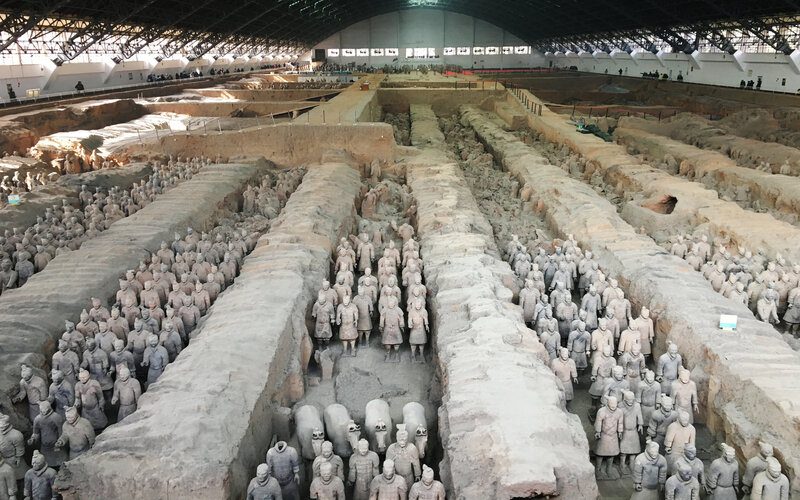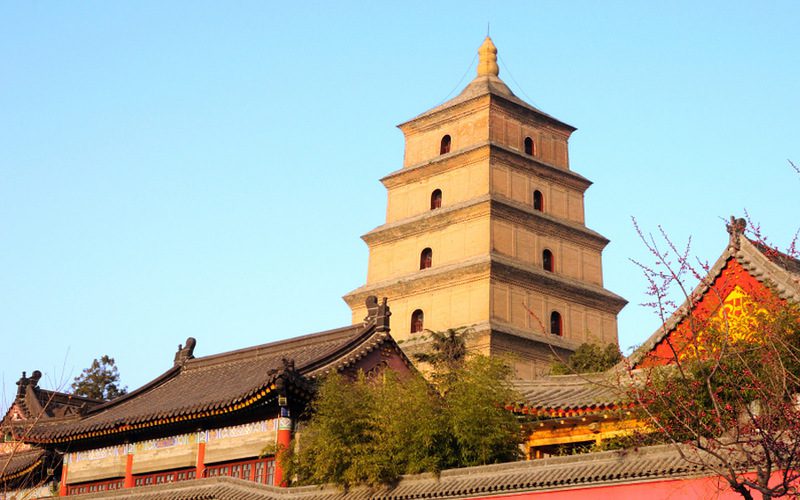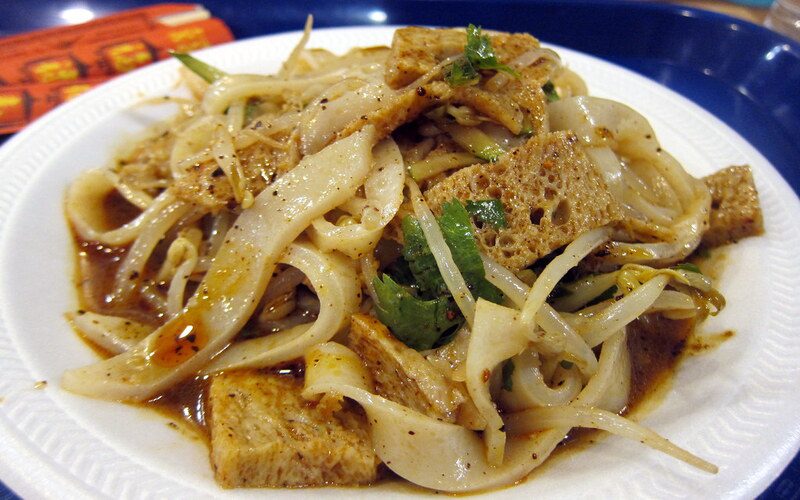In this Xian travel guide, we’ll provide you with essential information about climate, the best places to visit, activities to do, etc. Follow it to prepare for a perfect trip to China!
General Information
Located on the starting point of the ancient Silk Road, Xian (which means ‘West Peace’ in Chinese) used to be the imperial capital of China for 13 dynasties in 1000 years. Historically named Changan, Xian is considered the root of Chinese civilization, listed among the four greatest ancient capitals of China besides Beijing, Nanjing, and Luoyang. With long-lasting history, it is understandable that Xian is the home to various museums and cultural relics. This city also has rich culture due to being a bridge between Eastern and Western trading. Nowadays, Xian attracts thousands of tourists every year and it is said that: ‘If you don’t visit Xian, you haven’t been to China’.

Panoramic view of Xian
Climate and Best Time to Visit Xian
Xian has a typical climate of temperate and continental monsoon climate, with four distinct seasons: spring, summer, autumn, and winter.
- Spring (From March to May): Spring in Xian is generally mild, with fluctuating temperatures. The weather gradually warms up, with temperatures ranging from around 10 °C (50 °F) to 20 °C (68 °F) during the day. However, evenings and nights can still be chilly.
- Summer (From June to August): Summers in Xian are hot and humid. The average daytime temperatures range from 25 °C (77 °F) to 35 °C (95 °F), with occasional heatwaves pushing temperatures higher. However, thunderstorms and heavy rainfall are also common, providing some relief from the heat.
- Autumn (From September to November): Autumn is considered the best time to visit Xian, as the weather is pleasant and the city showcases beautiful fall foliage. Temperatures start to cool down, with average daytime temperatures ranging from 15 °C (59 °F) to 25 °C (77 °F) and it can be cooler in the evenings.
- Winter (From December to February): Winters in Xian are cold and dry, with occasional snowfall. Daytime temperatures hover around 0 °C (32 °F) to 10 °C (50 °F), but at night, temperatures can drop below freezing.

The climate of Xian
The best time to travel to Xian is Spring or Autumn. These periods offer the most pleasant weather and favorable conditions for exploring the city. Visiting during these seasons allows you to avoid the extremes of summer heat or winter cold, ensuring a more enjoyable experience. However, it’s worth noting that Xian is a year-round destination, and each season has its own unique charm. If you don’t mind colder temperatures and want to participate in skiing, winter can offer a quieter experience, while summer can be a good option if you plan to explore indoor attractions or experience local festivals.
Getting to Xian
By Plane
The plane is the common way to travel to Xian, China. Xian Xianyang International Airport (XIY) serves as the main airport for this city. It has both domestic and international flights connecting Xian to major cities around the world. Many domestic airlines operate direct flights to Xian from major cities in China. Once you arrive at the airport, you can take a taxi, airport shuttle bus, or the airport metro line to reach the city center.

Xian Xianyang International Airport
By Train
Xian has well-developed railway connections, and it is served by several train stations. Xian North Railway Station and Xian Railway Station are the main stations for high-speed and regular trains, respectively. There are high-speed train services connecting Xian to major cities like Beijing, Shanghai, Guangzhou, and Chengdu. The journey times vary depending on the distance. You can purchase train tickets online or at the train station.
By Bus
Xian has an extensive long-distance bus network connecting it to other cities and regions. There are several bus terminals in Xian, including Xian Bus Station, Xian Fangzhicheng Bus Station, and Xian Sanfuwan Bus Station. Buses offer a more affordable option compared to trains or flights. The duration of the journey depends on the distance and road conditions.
By Car
If you prefer driving, you can reach Xian by car. Xian is well-connected to other cities in China through an extensive highway network. However, keep in mind that driving in China may require a Chinese driver’s license, and traffic conditions can be challenging in major cities.
Getting around Xian
Thanks to its well-developed public transportation system and various modes of transportation available, it’s very easy for you to get around Xian City.
By Metro
Xian has a metro system with multiple lines that cover the city and connect major attractions and transportation hubs. It is an efficient and affordable way to travel within Xian. The metro operates from early morning until late evening, and signs and announcements are usually in both Chinese and English.

Metro in Xian, China
By Bus
Xian has an extensive bus network that covers the city and its surrounding areas. Buses are a popular mode of transportation, offering many routes and frequent services. However, you should have a basic understanding of the bus routes and stops before traveling, as some signs and announcements may be in Chinese only.
By Taxi
Taxis are widely available in Xian, and they are a convenient option for getting around, especially for shorter distances or when traveling with luggage. Taxis in Xian are usually metered, but it’s a good practice to ensure the driver turns on the meter. It’s recommended to have your destination written in Chinese characters or use a navigation app to communicate with the driver.
By Bike
Xian has a bike-sharing system with many bicycle stations throughout the city. You can rent a bike using a mobile app and pay for the duration of usage. Biking is a popular way to explore Xian’s city wall or navigate through smaller streets and alleys.
On Foot
In fact, this city has a compact city center with many attractions located within walking distance of each other. Walking is an excellent option for exploring specific areas or experiencing the local atmosphere. Be prepared with comfortable walking shoes, especially when visiting sites like the Muslim Quarter or the Bell and Drum Towers.
Accommodation in Xian
Xian offers a variety of accommodation options to suit different budgets and preferences. From luxury hotels to budget-friendly guesthouses, you can find a range of choices in different areas of the city. When choosing accommodation in Xian, you should consider factors such as location, transportation hubs, amenities offered, and your budget. Popular areas to consider for accommodation in Xian include the city center, near the Bell and Drum Towers, the Muslim Quarter, and near the Xian City Wall. These locations offer easy access to major attractions, transportation options, and a range of dining and entertainment choices. Here are some hotels to reference:
- The Westin Xian
- Crowne Plaza Xian
- Gran Melia Xian
- Shangri-La Xian
- Grand Park Xian
- Eastern House Boutique Hotel
- Regal Airport Hotel Xian

Grand Park Xian
Best Places to Visit in Xian
Terracotta Army Museum
The Terracotta Army is one of the most iconic and must-visit attractions in Xian. It is a vast collection of life-sized clay soldiers, horses, and chariots that were buried with Emperor Qin Shi Huang to protect him in the afterlife. The archaeological site is located about 40 kilometers east of the city center and offers a remarkable glimpse into ancient Chinese history. There are three vaults on this site for you to discover: Vault 1 with 2000 terracotta warriors, Vault 2 displays the army in battle arrays, and Vault 3 for a command post.

Terracotta Army Museum in Xian
Ancient City Wall
Built during the Ming Dynasty in the 14th century, Xian Ancient City Wall is considered one of the most magnificent military defensive systems in the world. It is a UNESCO Heritage Site that attracts thousands of tourists every year. The wall is 12 meters in height with 98 ramparts to avoid enemies climbing up. The highlight of this ancient wall is the 120-meter flanking tower which was used to enable the feudal soldiers to be cautious of enemies climbing up the wall. Cycling along the wall is the most exciting activity so that you can see the whole panoramic view of this splendid construction.

Xian Ancient City Wall
The Great Mosque
The Great Mosque of Xian is recognized as the largest mosque in China. Constructed during the Ming Dynasty (more than 400 years old), this mosque is a combination of Islamic and traditional Chinese architecture. Five elements of feng shui (wood, fire, earth, metal, and water) can be found in this mosque’s architecture. Chinese and Arabic calligraphy artworks are displayed across the complex. The Great Mosque is divided into five courtyards and the prayer hall is located in the fourth courtyard. You are welcome to visit this mosque even if you are not a Muslim. However, only Muslim pilgrims can enter the main prayer hall.

The Great Mosque of Xian
The Shaanxi History Museum
Used to be the capital of 13 imperial dynasties, Xian hold a strategic position in feudalism. This city is endowed with various historical relics and imperial sites. A 5-minute drive from Big Wild Goose Pagoda, Shaanxi History Museum will widen our knowledge about Xian’s glamorous imperial past. Inspired by the Tang-dynasty style, this museum is relatively vast with a total area of 65,000 square meters. A collection of 370,000 historical relics and antiques is displayed in Shaanxi History Museum. This museum is divided into three parts: the General Exhibition Hall with exhibitions of ancient dynasties, the Local Themes Exhibition Hall with Silk Road and Porcelain exhibitions, and the Temporary Exhibition Hall.

The Shaanxi History Museum
Big Wild Goose Pagoda
Built-in the Tang Dynasty (more than 1000 years ago), Big Wild Goose Pagoda holds Buddhist sutras which were brought to China from India by Xuanzang. Xuanzang was a Chinese monk who completed a journey to India in order to bring the original copies of Buddhist texts to his country. The Pagoda has been under restoration process several times due to weather and war. It stands at 64 meters tall and offers a panoramic view of the city from its top.

Big Wild Goose Pagoda
Muslim Quarter
As a starting point of the Silk Road, many Arabic merchants came to Xian 1000 years old for trading and business. They gathered and established their own quarter – the Muslim Quarter. Nowadays, Muslim Quarter is a popular tourist attraction in Xian where you can find numerous street foods. Visitors can sample delicious local snacks, shop for souvenirs, and explore the Great Mosque of Xian, one of the oldest and largest mosques in China.

Muslim Quarter
Banpo Museum
Banpo Museum displays prehistoric artifacts and antiques of the Neolithic Yangshao culture. This museum enables tourists to visit excavated buildings which provide you with insights into Banpo people’s life. Production tools, household tools, and pottery-making equipment can be found here.

Banpo Museum
Bell and Drum Towers
The Bell Tower and Drum Tower are iconic landmarks in Xian. The Bell Tower is located in the city center and offers a great view of the surrounding area. The Drum Tower, situated to the northwest of the Bell Tower, showcases ancient drums and offers cultural performances. Both towers are beautifully lit up at night, making them a spectacular sight.

Bell and Drum Towers
Must-Try Activities in Xian
Visiting the most important archeological excavation – the Terracotta Warriors
As an ancient capital, it’s no doubt that Xian is the home to hundreds of attractive sites. Terracotta Army is considered the most important archeological excavation in China which was only found in 1974, and also a must-see attraction in Xian. It was constructed as a funerary art to accompany Qin Shi Huang’s tomb, the first emperor of China.
Cycling through the City Wall
Coming to Xian, don’t forget to take a stroll or rent a bicycle to explore the ancient City Wall of the city. The well-preserved wall offers panoramic views of the city, and walking or cycling along its 14-kilometer length is a great way to appreciate the history and beauty of Xian.

Experience the Xian City Wall bike tour
Enjoying Street Food at Muslim Quarter
As a starting point of the Silk Road, Muslim Quarter is a popular tourist attraction in Xian where you can find numerous street foods. Delicious noodles, bread, and vermicelli which are eaten with lambs and beef are easily found here. If you are a vegetarian, it is not the right place for you. Some dishes you can try are Yangrou paomo (Flatbread in mutton soup), Rou Jia Mo (Chinese hamburger), and soup dumplings.

Enjoying street food at Muslim Quarter
Watching an Imperial Show
Enjoying a Tang Dynasty Show in Tang Dynasty Palace (Tang Yue Gong) in the evening is the best way to finish a day in Xian. It is also a dinner restaurant and you can try savory dumplings while watching incredible music and dance shows. Tang is one of the most prosperous dynasties of Chinese feudalism and art and culture developed brilliantly in this era. Tang Dynasty Music and Dance shows praise for the outstanding contribution of this dynasty to the Chinese imperial era.

Tang Dynasty show
Must-Try Foods in Xian
Located in Northwestern China, Xian cuisine is a mixture between the North and the South. Due to its geographical location, Xian is between Shanxi and Sichuan. The foods here are both sour (Shanxi) and spicy (Sichuan). However, this region is arid compared to eastern China, rice is not the main crop here. Visitors will find more noodles, bread, and dumplings in Xianese restaurants.
Yangrou paomo (Flatbread in Mutton Soup)
Yangrou paomo is the local specialty of Xian and is popular among international travelers. A bowl of vermicelli and shredded flatbread in the aromatic mutton broth will warm your body up immediately. The chefs add many seasonings to the broth, for example, shallot, ginger, aniseed, fennel, cassia, etc. to create an appealing taste. The unique feature of this dish is that it is eaten with baked pancakes. Baked pancakes are cut into small pieces and topped with broth. Yangrou paomo is a Muslim dish, thus, it can easily be found in Muslim Quarter.

Yangrou paomo (Flatbread in mutton soup)
Liangpi (Cold Noodles)
Xian is more famous for delicious noodles than anywhere else in China. Liangpi is a kind of cold noodle that seems not to be appealing when you first hear of it. This food is made from thinly sliced rice noodles which are boiled, then set aside until it is cooled. Chili oil, pepper powder, sesame oil, vinegar, and diced garlic will be put at the top of the rice noodles. Beef, pork, and egg can be added to Liangpi if you like.

Liangpi (Cold noodles)
Qishan Noodles
This dish has a long history since Qing Dynasty. It originated in Qishan County of Xian. The soup of this dish is sour and spicy with Sichuan pepper. The noodles are hand-made with wheat flour; hence the taste is really chewy. Pork shreds, chicken, egg, mushrooms, and green onion are topped on the top of the noodles.

Qishan noodles
Biang Biang Noodles
Biang Biang is made from thick and savory wheat flour filled with eggs and oil. This dish is served with pepper, diced garlic, and vinegar. Topped with meat and leafy vegetables, Biang Biang is extremely delicious with thick chewy noodles and rich broth.

Biang Biang noodles
Soup Dumplings (Tangbao)
People could argue that soup dumpling is the local specialty of Shanghai. However, you can taste a different version of this dish in Xian. The Xian version is made with lamb or beef instead of pork in Shanghai. Inside the dumpling wrapper, there is a perfect mixture of vegetables, meat, and soup that ultimately tantalizes your taste buds. Be careful since the soup inside is hot.

Soup dumplings (tangbao)
Rou Jia Mo (Chinese Hamburger)
Rou Jia Mo, which is a kind of Chinese sandwich, is loved by every traveler. This food has been widespread since Qin Dynasty (more than 2000 years ago). You can eat the sandwich with pork, but Muslims usually choose beef or lamb. The meat is sophisticatedly cooked with 20 kinds of spices and stewed for hours. That’s why it has a beautiful red color, appealing aroma, and unforgettable flavor.

Rou Jia Mo (Chinese hamburger)
Hu Lu Ji (Xian Gourd Chicken)
This dish is unique with crispy skin on the outside and tender on the inside. The chicken is poached and then deep-fried to create delicious golden skin. Often served with chili, fennel, and salt, it is a popular dish for both local people and tourists.
Fenzhengrou (Steamed Beef with Wheat Powder)
The name of this dish refers to juicy meat wrapped in crispy toasted rice. Pork belly or beef is cut into slices and seasoned with a special sauce. Then, the meat is mixed with rice powder and steamed for hours.

Fenzhengrou (Steamed beef with wheat powder)
Xian offers a wide range of tourism experiences, including historical sites, cultural landmarks, delicious cuisine, and immersive cultural activities. It is a fascinating destination that offers a blend of ancient history and modern development, making it a popular choice for both domestic and international tourists. Please contact us for more details if you are planning a trip to Xian in the near future.
